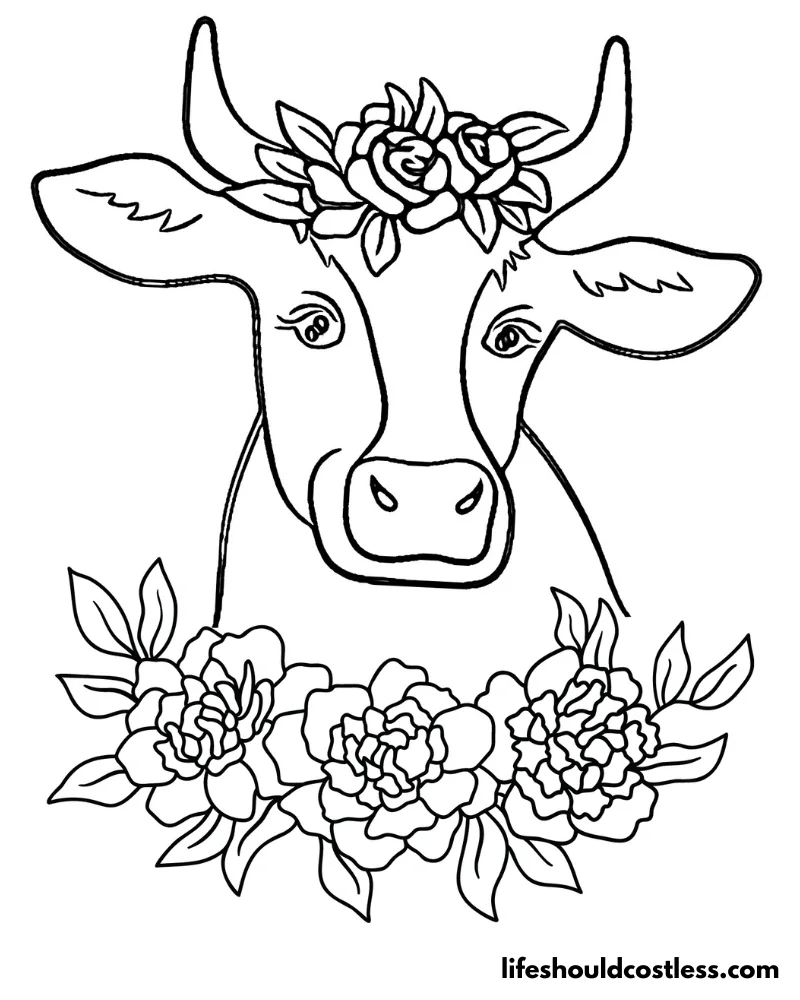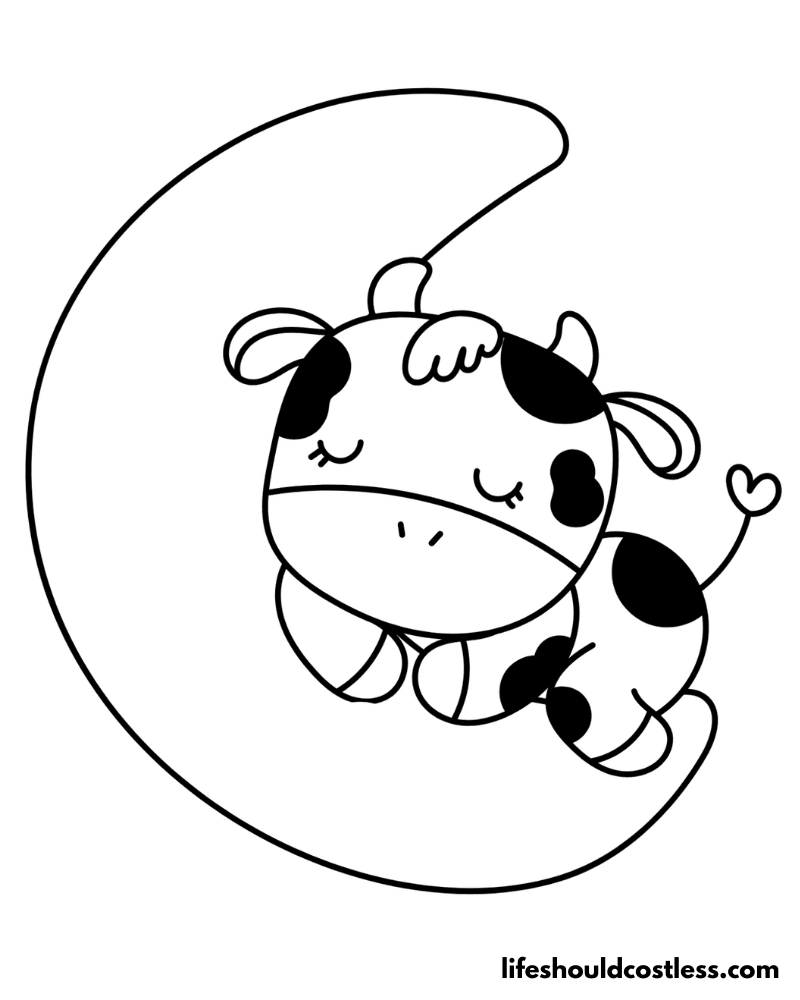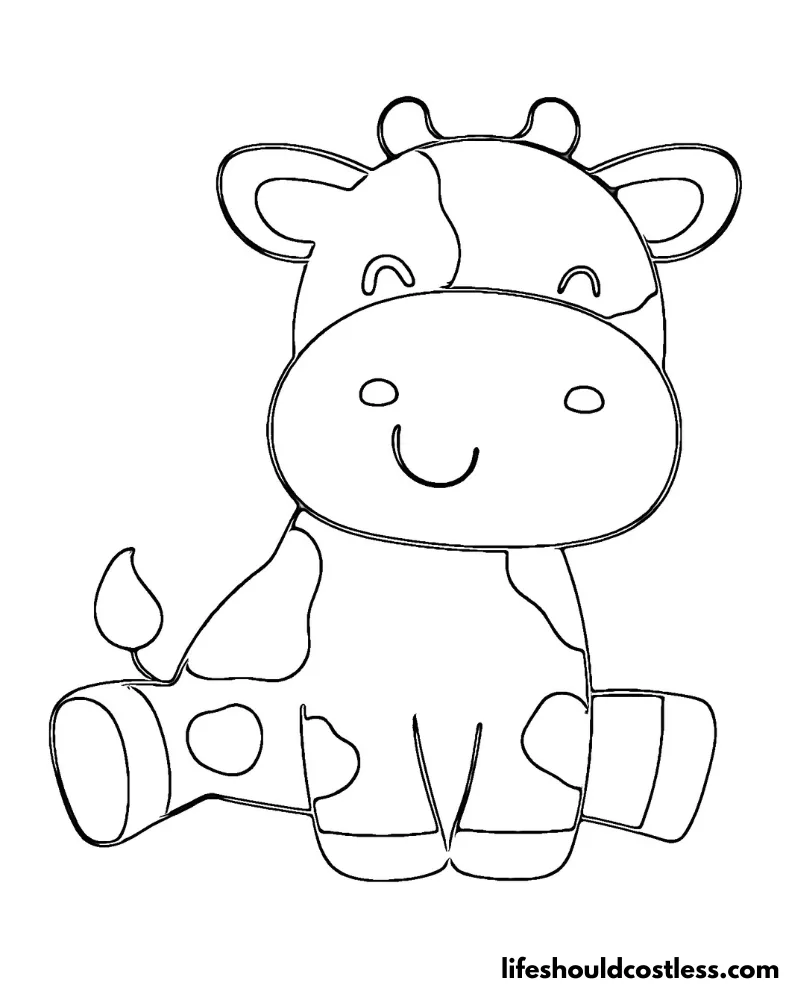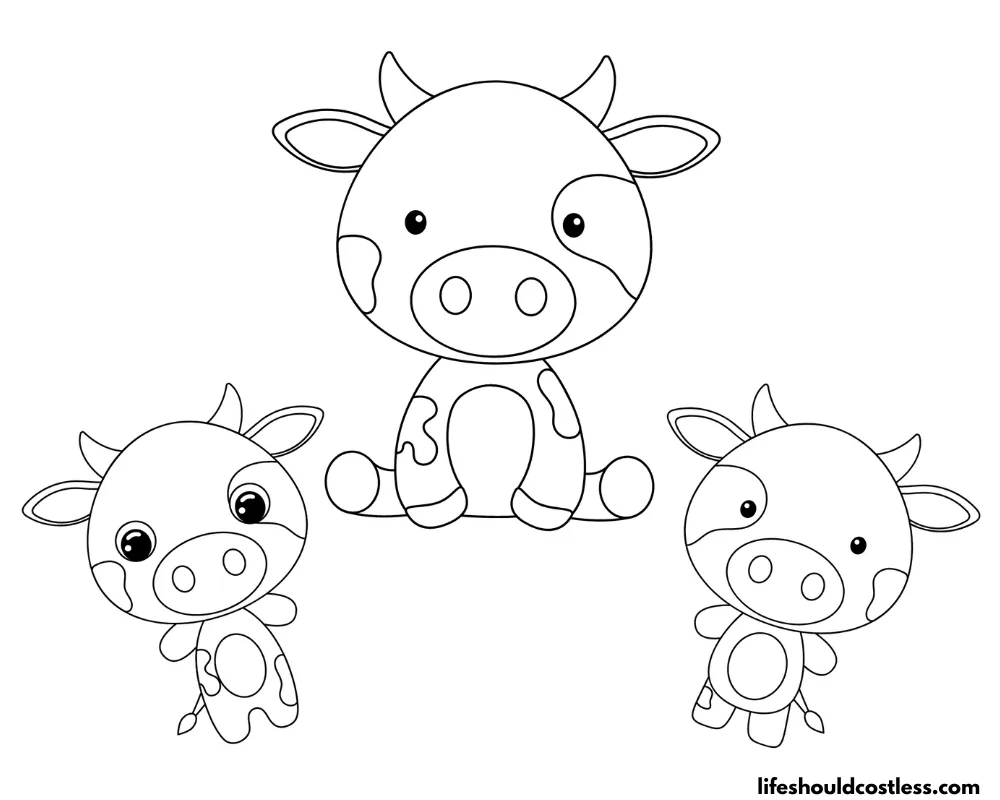Welcome to the delightful world of cow coloring pages, where creativity meets with bovine beauty! These delightful coloring sheets offer an exciting and educational journey into the world of cows. Whether you’re a child, an adult seeking relaxation, or an aspiring artist, these free cow printables provide a canvas for your imagination to run wild.

Just pick whichever design you like, save the downloadable free PDF template, print it out, and get coloring to your little hearts content.
Or you could even use them as an embroidery pattern or inspiration for fine line tattoos.
Cow facts
If you’re new to my coloring pages, you should know that I like to give you the option of learning about the subject so that you can easily turn it into an educational lesson while you are at it…so here we go!
Here are some, simplified, fun and interesting facts about cows (& here is the link to my source):
- Cows belong to the genus Bos: Cows are domesticated herbivorous animals that belong to the genus Bos, which also includes other bovine species like bison, yaks, and water buffalo.
- Cattle have been domesticated for thousands of years: The domestication of cattle dates back to around 10,000 years ago, making them one of the earliest domesticated animals.
- Cows have a specialized digestive system: Cows have a unique digestive system with a four-chambered stomach. This allows them to efficiently break down and digest plant material, including tough cellulose.
- There are numerous cattle breeds: There is a wide variety of cattle breeds around the world, each with its own distinct characteristics, including size, coloration, and purpose (such as dairy or beef production).
- Cows have a large field of vision: Cattle have a panoramic field of vision, which allows them to see almost 360 degrees without having to turn their heads.
- They communicate using various sounds: Cows use a range of vocalizations to communicate with each other, including moos, grunts, and bellows. These sounds serve different purposes, such as indicating distress, seeking attention, or locating their calves.
- Cows have an acute sense of smell: Cattle have a highly developed sense of smell and can detect scents from long distances. They use their sense of smell to locate food, identify herd members, and recognize their surroundings.
- They have a strong maternal instinct: Cows are known for their strong maternal instincts. They form close bonds with their calves, and mother cows are highly protective, often fiercely defending their young from potential threats.
- Cattle can live for many years: The lifespan of a cow varies depending on factors such as breed and environment. On average, cows can live for around 15 to 25 years, although some may live longer.
- Cows have a complex social structure: Cattle live in hierarchical social structures within their herds, with dominant individuals establishing leadership. They form social bonds and develop relationships within their groups.
- Cows are ruminants: Being ruminants, cows chew their food partially and then regurgitate it to chew it again. This process, called rumination, allows them to break down and extract nutrients from plant material more effectively.
- Cows are vital for food production: Cattle play a crucial role in providing various food products, including meat, milk, and dairy products, which are essential components of many diets worldwide.
These fun and interesting facts offer a glimpse into the fascinating world of cows and their significance in human history and agriculture.
Here are a few other reputable sources on information about cows if you would like to do some more learning while you are at it:
- https://www.clovermeadowsbeef.com/amazing-facts-about-cows/
- https://kids.britannica.com/kids/article/cattle/352928
- https://animalcorner.org/animals/cows/
- To see all of my free printables, go here.
- If you would like to see an alphabetized index of free printable coloring pages, go here!
- All of my animals coloring pages are found here.
- Or, my other mammals coloring pages can be found here.
Coloring tips
Here are some tips to help you create a vibrant and engaging coloring sheet of a cow:
- Observe reference images: Look at real cows, photographs, or illustrations to understand the cow’s anatomy, features, and color patterns. This observation will provide you with a better understanding of how to color your cow accurately.
- Start with light colors: Begin coloring with lighter shades, especially for the base coat. Light colors allow you to layer darker shades later, creating depth and dimension in your artwork.
- Layer colors for texture: Cows have various textures on their coats, such as smooth areas and patches of spots or speckles. Use different shades and hues to layer colors, adding texture and visual interest to your cow coloring page.
- Consider the breed: If you are coloring a specific breed, research the typical coloration of that breed. Different breeds have distinct color patterns and variations, so try to replicate those characteristics for a more accurate representation.
- Experiment with shading and highlighting: Shading and highlighting techniques can enhance the three-dimensional effect of your coloring. Add shadows in areas where light wouldn’t reach, and highlight certain areas to create contrast and depth.
- Play with color combinations: While black and white is often thought of as the most common cow coloration, don’t be afraid to experiment with different color combinations. Try using varying shades of browns, grays, or even vibrant colors to create unique and imaginative cow designs.
- Use colored pencils or markers: Colored pencils allow for more control and blending, while markers offer vibrant and solid colors. Experiment with different mediums to find the one that suits your coloring style and preferences.
- Add background elements: Consider incorporating a background into your cow coloring page to enhance the overall composition. It could be a farm setting, a meadow, or even a whimsical scene. The background adds context and visual appeal to your artwork.
Remember, coloring cow pictures to color is a creative process, so don’t be afraid to experiment, try new techniques, and have fun with your cow print printable.
Let your imagination guide you, and enjoy the journey of bringing these gentle creatures to life with your colors!
Options for printing
Letter C is for cow writing practice worksheets
*My letter C is for Cow coloring sheet printables are specifically designed to be used in a classroom setting, they are the only printable options on this page that do not need written permission to use in a public setting.
Please send the link to this post along if anyone asks you where you got them. Thank you!


Cow Face


Cartoon Cows



Baby Cows




FAQ’s
The color of cow skin can vary depending on the breed and individual characteristics. The most common color of cow skin is usually shades of white, with patches or spots of other colors.
For example, Holstein cows have predominantly white skin with black patches or spots, while Jersey cows have light brown or fawn-colored skin.
Additionally, some cows may have solid-colored skin, such as solid black in Angus cows or reddish-brown in Guernsey cows.
It’s important to note that the color of cow skin often corresponds to the color of their coat or fur.
Dairy cows come in various colors, but the most common color pattern among dairy breeds is black and white, often referred to as the Holstein pattern.
Holsteins are known for their striking contrast of large black patches on a predominantly white coat. These patches can vary in shape, size, and distribution across the body. The black patches typically cover the head, neck, and body, with variations ranging from solid black spots to irregular shapes.
The white areas on a Holstein’s coat are typically a bright, clean white color, creating a distinct contrast against the black patches. The white can extend from the forehead down the face, often including the muzzle and jawline. It continues along the neck, chest, belly, and limbs, giving Holsteins their characteristic appearance.
It’s important to note that not all dairy cows are black and white. Other color patterns and breeds exist within the dairy industry. For example, Jersey cows are often a shade of fawn or light brown, sometimes with a white face or patches. Guernsey cows have a reddish-brown coat with white patches, and Brown Swiss cows have a solid brown or gray coloration. These breeds, along with others, contribute to the diversity of colors seen in dairy cows.
While black and white Holsteins may be the most visually recognizable due to their prevalence in many countries, it’s crucial to appreciate the variety of colors and patterns found within the dairy cow population. Each breed’s unique coat color adds to the charm and beauty of these remarkable animals, reflecting the rich history and traditions of dairy farming worldwide.
The most common cow color is black and white, which is known as the Holstein pattern. Holstein cows are the most prevalent breed worldwide and are known for their distinctive black and white spots.
This coloration is a result of genetic factors and has become synonymous with cows in many people’s minds.
However, it’s important to note that there are several other cow colors and patterns as well, including solid black, solid brown, red and white, and more. Each breed of cow has its own unique color variations, making the bovine world a visually diverse and fascinating one.
The most common cow color can vary depending on the region and specific breed of cattle. While black and white Holsteins are widely recognized and prevalent in many countries, it is essential to consider other popular breeds such as Angus (solid black), Hereford (red with white face and belly), and Simmental (brown and white). These breeds, among others, contribute to the diversity of cow colors worldwide.
*I will add more cow colour / color questions and answers as the questions get sent to me.
In conclusion, cow coloring pages offer a wonderful opportunity for children and adults alike to engage in a creative and educational activity.
These delightful depictions of cows not only encourage artistic expression but also provide a platform for learning about the fascinating world of these gentle creatures.
Whether it’s discovering the different breeds, understanding a cows role in agriculture, or simply appreciating their unique features, these coloring pages of a cow bring joy and knowledge together.
So, grab your favorite colors and embark on a coloring adventure that celebrates the beauty and charm of these lovable farm animals.
Let your imagination run wild as you fill the pages with vibrant hues, and let the experience of coloring pictures of cows be a source of inspiration and delight.
Thanks so much for stopping by my blog and supporting my endeavors to make people’s lives a little easier/better/more affordable.
If you liked this post, or found it helpful in any way, please make sure to share it with your family, friends, and co-workers via social media.
Or you could even send them the direct link via email. Whichever way you choose to spread the love, I super appreciate it! ~Sarah

Follow me
How To Follow & Support This Site
- If you would like to subscribe to my email list, go here.
- Make sure to follow along via social media, by going here.
- If you would like to learn how to really show your support to this site (at no cost to you), go here.
- If you would like to make a direct donation to the site, go here.
Check out my other free printables
- To see all of my free printables, go here.
- If you would like to see an alphabetized index of free printable coloring pages, go here!
- All of my animals coloring pages are found here.
- Or, my other mammals coloring pages can be found here.
Otherwise, here are direct links to several of my other related posts that you’re also going to love:
Animals / Mammals
Animals / Birds
Animals / Insects
Other good resources for a printable cow
- https://www.dreamstime.com/illustration/cow-coloring-page.html
- http://bestcoloringpages.com/cows-coloring-pages_1p791.html
- http://www.honkingdonkey.com/coloring-pages/cattle/cow-coloring-003.htm
*This post was originally shared to this blog on 05/12/2023, & has since been updated to improve user experience, add video instruction, as well as to make it as shareable as possible across the social medias.
**Please note that I do try my hardest to provide factual, but easy to understand, information about each topic. If you notice a discrepancy in my coloring pages, facts, or see something that you deem “misinformation/incorrect” please make sure to notify me about it. I would prefer that you send me an email with a link to a more reputable resource on that subject, so that I can correct it as soon as possible. Thanks so much for helping this site become the best that it can be!
***Resources from djinkers were used in the production of this article.
